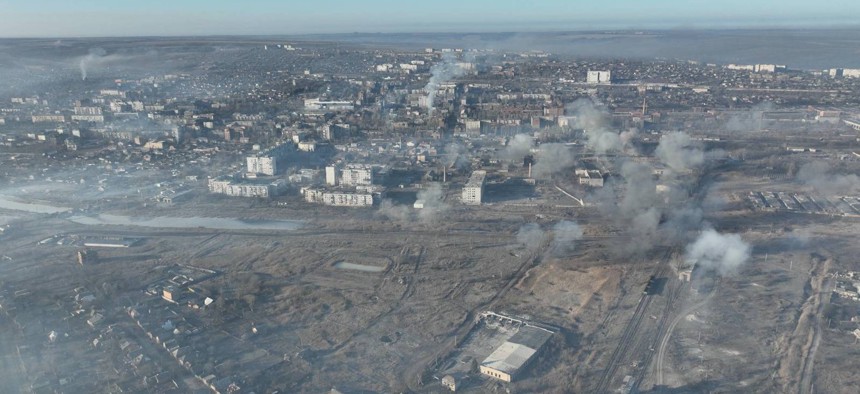
Smoke rises after Russian forces shelled the city of Bakhmut, in Ukraine's Donetsk Oblastm on January 27, 2023. an Dobronosov/Global Images Ukraine via Getty Images
Urban Combat Is Changing. The Ukraine War Shows How
Four attributes distinguish today’s city battles from those that have come before.
How does urban warfare in Ukraine, where the adversaries are relatively balanced nation-states, differ from recent Fallujah- or Mosul-type battles between states and non-state armed groups?
It is useful to start with a list of urban warfare’s unique features and challenges, such as the one I produced in a 2019 study on urban warfare in strategic competition. In this study, a review of joint/allied doctrine, subject-matter expert discussions, historical case studies, and hypothetical vignettes suggested that most of the features and challenges present in historical battles are likely to be intensified in great power competition (today’s “strategic competition”). Strategic competition is also likely to bring four new features and challenges.

Indeed, in Ukraine we have seen all eight features and challenges of historical urban warfare identified in the 2019 study. For instance, both Ukrainian and Russian forces have been constrained by the physical terrain of cities, long a feature of urban combat. High-rise structures have shaped what weaponry and equipment can be used, demanded decentralized command and control, and generated casualties. The other seven features and challenges of historical urban warfare are also present, including the need for rapid and decentralized decision-making under uncertainty; challenges of information management; effective ISR, targeting; and expeditionary logistics and medical care; and elements of the “Three-Block War” and manpower-intensive and stressful operations.
The postulated four new features and challenges of urban warfare in strategic competition have also been observed in Ukraine.
First, simply reaching the urban area of operations has proven difficult. Unlike the United States’ experience with relatively permissive urban environments in Iraq and Afghanistan during the past twenty-plus years of counterinsurgency operations and even Azerbaijan’s experience in the fighting over Shusha in 2020, Russia has struggled mightily to gain entry to the urban areas of Ukraine. Russian forces have sustained unexpected losses and resorted to siege tactics in city after city across Ukraine as a result.
Second, the urban battles have featured multiple contested domains, including air, land, and subterranean. This stands in contrast to prominent historical examples such as Fallujah in 2004 and the more recent episodes in Mosul and Shusha, in which most of the combat was largely concentrated in the land domain.
Don't miss:
Third, urban battles in Ukraine have seen a wider mix of regular and irregular forces with better capabilities than has been the case in past decades. Russia has used regular troops, conscripts, proxy forces, mercenaries like the Wagner Group, and even Syrians to conduct operations in urban areas with little regard for civilian lives or infrastructure. The result has been high levels of casualties and destruction. From the U.S. military’s perspective, future urban warfare can be expected to contrast with its urban fights over the past twenty years, in which opposing forces largely used irregular tactics and had lower-level capabilities (e.g., small arms and light weapons). Urban warfare in strategic competition can also be expected to involve adversaries (like Russia) that employ less restrictive rules of engagement than U.S. forces.
Finally, while the electronic spectrum was contested in Mosul, Ukraine constitutes the first real instance where both sides are truly fighting for control of the spectrum in urban combat, using jamming to challenge the other side’s communications and its operation of equipment like drones.
These findings imply three main lessons for defense policymakers and planners in the U.S. and its Western allies and partners. First, it is clear that urban warfare will continue to play a central role in armed conflict (including when nation-states clash), so both policymakers and planners should keep this in mind when preparing for military operations. Military analysts and observers of the operations in Ukraine should focus on deriving lessons from urban warfare, particularly concerning the implications of the four new features and challenges.
Second, much of the doctrine underpinning urban operations for the U.S. Army and Marine Corps is outdated and has not been updated to incorporate the contemporary operating environment and adversary capabilities. The services should consider rewriting this key doctrine to reflect what has been observed in Ukraine, with a particular focus on the parts that are new.
Finally, it is not enough for the U.S. Army and Marine Corps and other American allies and partners to train for urban operations using two-story sandstone “MOUT towns” in the middle of nowhere that try to approximate Middle Eastern/South Asian cities and villages. Rather, these forces need to undertake realistic urban training, going out into actual cities for exercises and training, like the 31st MEU recently did in Oahu. Only then can they get an approximation of what Russian and Ukrainian forces are experiencing in Ukraine’s cities and truly be as prepared as possible for the likely city fight to come in the future against adversaries.
Dr. Sam Plapinger is a Research Scientist at CNA, a nonprofit, nonpartisan research and analysis organization in Arlington, Virginia. From 2020-2022, he served as the embedded CNA field representative to the commander of U.S. Naval Forces Central Command/Fifth Fleet in Bahrain, conducting on-site research and analysis for the senior U.S. Navy commander in the Middle East. At CNA, his work has focused on strategic competition, irregular warfare, force design, fleet operations, and Middle East security issues. The views expressed are those of the author and do not reflect the official position of CNA or any of its sponsors.



